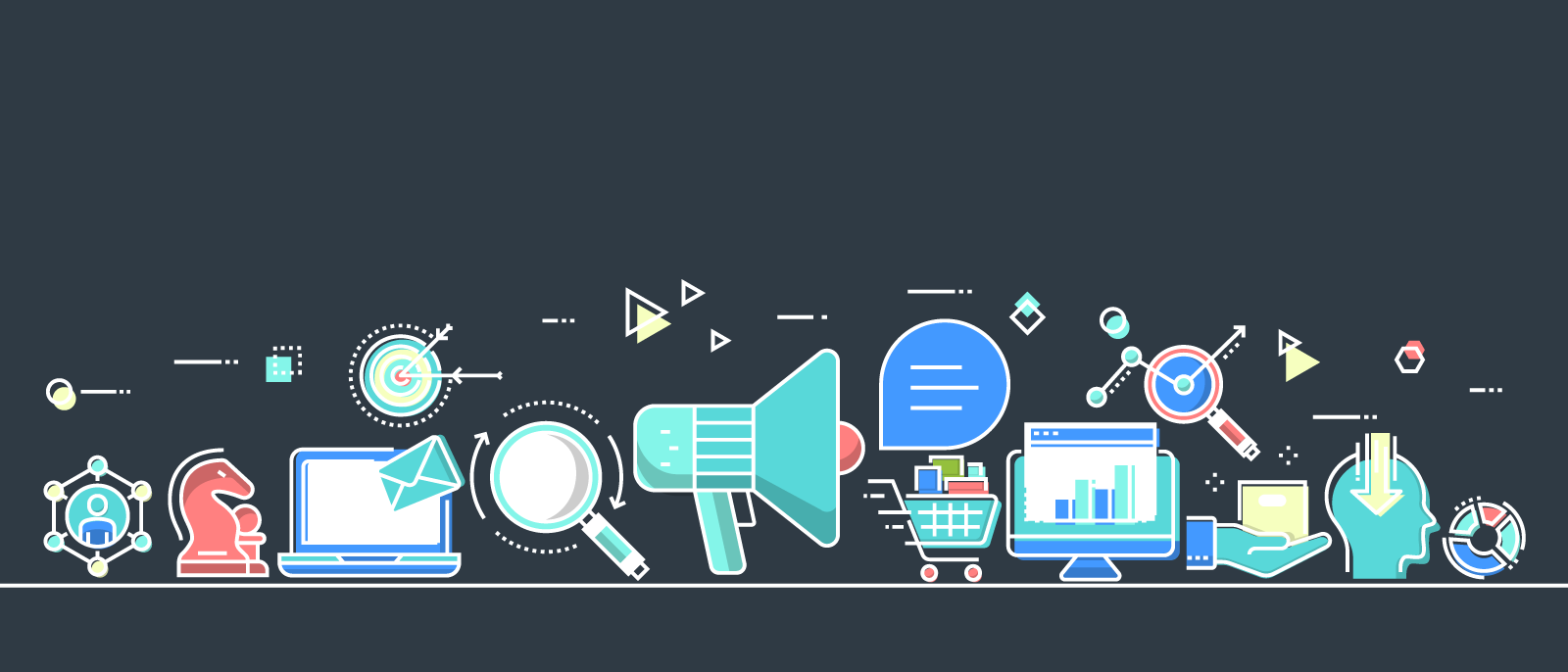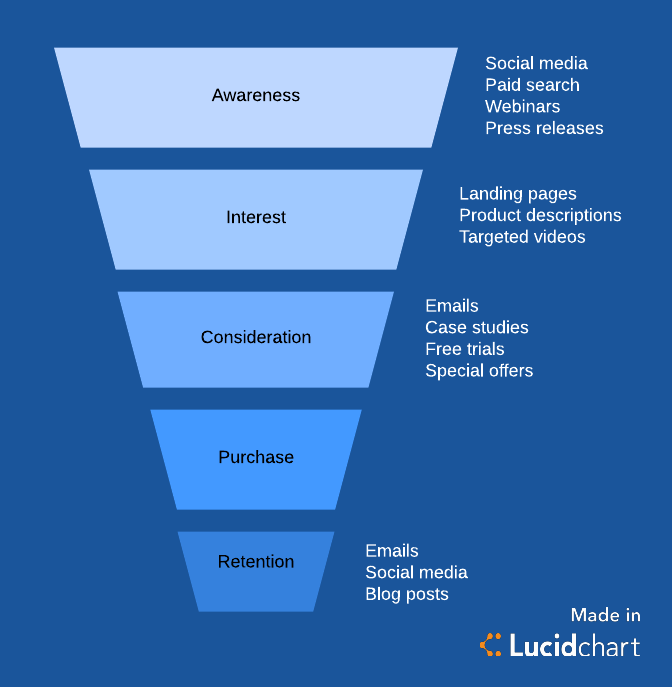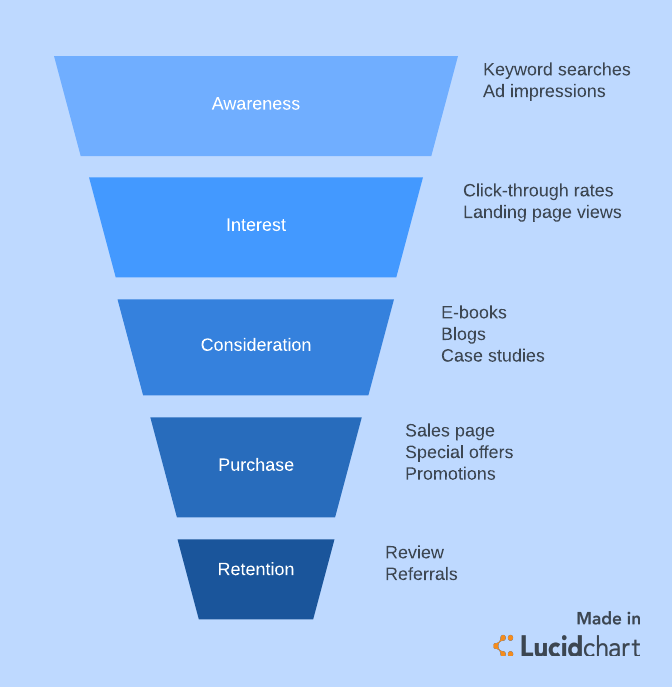
How to refine your marketing funnel and earn devoted customers
Reading time: about 7 min
Topics:
Think about the last time you made a purchase, whether it was big or small, online or in-store.
You needed to solve a problem. (Let’s assume you were hungry.) You looked for a product or service that could help. (You searched on your phone for nearby restaurants.) You considered which offer would best fill your need. (McDonald’s was only five minutes away, but you live for the Crunchwrap Supreme.) Then you made a decision. (Taco Bell, it is!)
Every customer goes through these basic steps, and marketing teams can examine how customers find their company and why they ultimately choose their company through the marketing funnel.
If you can’t remember the last time you and your team took an in-depth look at your marketing funnel, then it’s time to do so. By evaluating the marketing funnel regularly and using Lucidchart to map it, your team can easily appeal to potential customers and hang on to loyal ones.

What is a marketing funnel, actually?
A marketing funnel refers to the journey that potential customers to find your brand and eventually purchase your product or service.
The term marketing funnel is often used alongside terms like sales funnel and customer journey funnel. We have a shocking revelation for you: each of these funnels refers to the same basic steps since sales and marketing need to corporate and understand the same customer journey to ultimately close a deal.
Identifying the marketing funnel will allow you and your team to figure out ways to better attract and communicate with your customers.
Marketing funnels apply to any industry, brand, or company type, and though they may diverge on finer points, they include the same basic stages:
- Awareness/exposure
- Interest
- Consideration
- Purchase
- Retention
Bear in mind that your customers may follow a less linear path, and that’s okay. Your customers might also follow a different customer journey depending on whether you're part of a B2C or B2B company, and you can customize your marketing funnel to that journey, as shown in the template below.

Before you work on refining your own funnel, first refresh your knowledge about what should be happening in each of these phases.
Awareness/Exposure
During this phase, your potential customers don’t yet know your brand exists, so your first task is to introduce them to it. Consider tactics that introduce potential customers to who you are as a brand, such as:
- Ad campaigns
- Paid search
- Social media
- Webinars
- E-books/whitepapers
- Events/trade shows
- Press releases
- Blog posts (much like this one)
If you don’t make your brand accessible to potential customers in the awareness phase, they can’t progress any further into the funnel.
Interest
Once your customers are aware of your brand, you want to show them how it fits their needs. Your goal should be to build relationships with customers and introduce them to positioning.Try these strategies:
- Landing pages
- Product descriptions
- Targeted content
- Videos
Consideration
As customers move toward consideration, your job is to make their decision to buy your product or service an easy one. At this point, potential customers will compare your product or service with other brands, so you should demonstrate the ways you stand out. The right materials and incentives could be just enough to convince the prospect to commit to, rather than just consider, your product. This stage often involves:
- Emails
- Case studies
- Product reviews
- Product comparisons
- Free trials/demos
- Special offers
Purchase
If you do well in the consideration phase, commitment should follow naturally. Potential customers may need to justify their purchase to themselves, but if you’ve created an emotional connection with would-be customers, that justification will come easily.
During this phase, you should position your company to be readily available to handle any of the customer’s needs, whether they have questions or need purchasing help. Once a customer commits to your brand, you’ll have an easier time convincing them to make purchases in the future.
Retention
Potential customers become actual customers at the moment they decide to make a purchase, but your job doesn’t end there. Your marketing team will need to work to retain each customer’s loyalty with ongoing efforts, seeing them through the funnel multiple times as their needs change. You can send existing customers marketing materials such as:
- Support articles
- Emails
- Blog posts
- Social media
- Special offers
Bonus: Advocacy
Some companies have also considered that satisfied customers are likely to bring in new customers through word-of-mouth. Give existing customers an opportunity to pull new prospects into the consideration stage. You could ask them to leave a review, share pictures of them using the product, recommend a friend for some sort of reward, etc.
How to make your own marketing funnel template with Lucidchart
After re-familiarizing yourself with the concept of the general marketing funnel, sit down with your team and take a closer look at your own. Download our free Lucidchart template, and then follow these steps to make your own internal marketing funnel diagram. Communicating your marketing funnel and strategy to the company as a whole will improve interdepartmental collaboration over time.
1. Build your own unique template.
Don’t feel the need to follow a traditional marketing funnel exactly when designing your own. If your team feels strongly that certain steps can be added or removed, then do so. Lucidchart’s user-friendly design caters to customization, so decide on the steps that work for you and your brand, and then build them into a practical template.
You can even create a different marketing funnel for each brand of your marketing team (for example, digital marketing).

2. Evaluate your funnel and add actionable steps to each phase.
After you and your team decide which phases to include, evaluate how your company approaches—or should approach—each phase and fill your template with specific steps that your team members can take to improve. If you follow a traditional marketing funnel, that discussion and process could look something like this.
Awareness
What does your team do now to encourage brand awareness? What could you be doing better or more of? Can your team define your brand’s persona? Make a high-level assessment of your involvement in social media, blogging, and trade shows, and include that assessment in your document to remind your team of areas you could improve.
Interest
Are you tracking reviews, targeted emails or newsletters, and brand engagement with paid search and paid social? Outlining a big picture plan of the interest phase unites smaller tasks under one larger goal and could reveal gaps that inspire process refinement on other levels. Start recording your efforts and make that information accessible from your Lucidchart document to keep team members accountable.
Consideration
What does your brand do to help customers through the consideration phase? When was the last time you looked at what competitors were doing to give potential buyers more information about their products? Outline a plan or change a stale existing one to make sure your customers have a chance to experience your product or service with incentives like free trials before having to commit to it.
Purchase
What constitutes commitment for your brand? Is it a customer putting an item in a shopping cart or signing up for a specific service? Define the point at which you consider a customer “committed,” and then list any steps you take (or would like to take) to help them get there.
Retention
Does your brand have a specific strategy for customer retention? If so, outline it here. If not, set aside a larger amount of time to figure out what that strategy should be, and consider creating a separate Lucidchart document for a customer retention process.
3. Try Lucidchart for free.
Get started building your own marketing funnel in Lucidchart for free today.
Marketing funnels aren’t the easiest part of a business to define, especially as the Internet and social media have disrupted the traditional customer experience. Regardless of what your brand’s marketing funnel looks like, though, illustrating it gives you the opportunity to evaluate what you’re doing currently and what you could be doing better in the future.
Trust Lucidchart to craft your own version of the funnel, and you’ll be equipped with a framework that you can adapt to fit your brand’s goals and needs.
About Lucidchart
Lucidchart, a cloud-based intelligent diagramming application, is a core component of Lucid Software's Visual Collaboration Suite. This intuitive, cloud-based solution empowers teams to collaborate in real-time to build flowcharts, mockups, UML diagrams, customer journey maps, and more. Lucidchart propels teams forward to build the future faster. Lucid is proud to serve top businesses around the world, including customers such as Google, GE, and NBC Universal, and 99% of the Fortune 500. Lucid partners with industry leaders, including Google, Atlassian, and Microsoft. Since its founding, Lucid has received numerous awards for its products, business, and workplace culture. For more information, visit lucidchart.com.
Related articles
What is B2B2C? How the B2B2C business model works and benefits companies
B2B2C stands for business to business to consumer. Learn how it differs from B2B and how Lucidchart can help you implement it.
Marketing funnel vs customer journey maps
We're breaking down marketing funnels and customer journeys, explaining why they're so useful. Includes templates!
